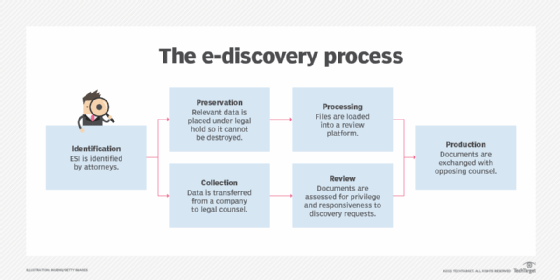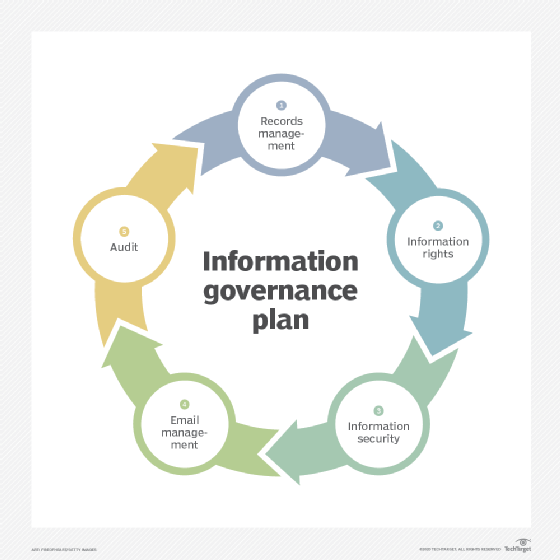Electronic Discovery Reference Model (EDRM)
What is the Electronic Discovery Reference Model (EDRM)?
The Electronic Discovery Reference Model (EDRM) is a conceptual framework that outlines activities for the recovery and discovery of digital data. It is a conceptual standard for the e-discovery process and also provides guidance for gathering and assimilating electronic data during legal proceedings, including criminal evidence discovery.
Electronic discovery and EDRM
Electronic discovery, or e-discovery, refers to the process of obtaining electronic evidence in a legal case or investigation. During this process, electronic data is sought, located, secured and searched for with the intent of using it as evidence during the investigation and litigation of the case.
The EDRM provides a standardized model for e-discovery. It consists of nine distinctive stages that allow for the management and discovery of electronically stored information (ESI) during an investigation.
This model was developed in 2005 by George Socha Jr. of Socha Consulting LLC and Tom Gelbmann of Gelbmann & Associates to address the paucity of e-discovery standards for legal purposes, specifically for the recovery and discovery of digital data. Today, many legal and investigative teams use EDRM to guide their e-discovery processes and activities.

EDRM stages
Anyone following EDRM for e-discovery could engage in some or all the below activities to successfully discover relevant data for a legal case or proceeding. These activities can be performed and completed iteratively. They can also be performed out of order. This flexibility is possible because EDRM is not a linear or waterfall model for e-discovery. Rather, it represents a conceptual view of the e-discovery process and provides guidance for e-data discovery, gathering and assimilation.
The various stages in the EDRM model include the following:
Information management and governance
In this stage, data governance processes are implemented to alleviate risk and expenses in the event of an electronic discovery request. The ESI is managed throughout its lifecycle (i.e., from creation to deletion and disposal) using various tools, procedures and policies. This stage is crucial because it creates a strong foundation for the safe, transparent and accountable handling and management of data right from the beginning of the litigation process.
Within EDRM, a separate model is available to streamline and standardize information governance. This model is known as the Information Governance Reference Model (IGRM).

Identification
Here's where sources of information are located to determine exactly what the ESI is and how it needs to be managed. Typically, activities like case reviews and interviews are used to identify ESI that may be relevant for e-discovery.
Preservation
This stage involves ensuring that potentially e-discovery-relevant ESI is properly stored so that it remains intact and available for e-discovery. Various measures can be used to prevent electronic data spoliation (tampering or destruction), compromise and alteration, including retention and deletion schedules. Some legal teams also place data on "legal hold" to freeze it and forbid any other department from deleting it.
Collection
After identifying and preserving ESI, legal teams gather it for e-discovery use. They collect the electronic data in a way that makes it usable throughout the legal process. The ESI is also made legally defensible so its authenticity cannot be questioned or doubted.
Processing
Before the ESI can be reviewed (e.g., by attorneys), it must be cleaned up and converted into a relevant format for further analysis. Its volume may also be reduced by removing irrelevant data. All relevant and useful ESI may then be placed in a single folder for easy retrieval.
Review
The review stage is one of the most important stages during e-discovery. It is also one of the costliest, especially if the reviewers use manual or "by eye" methods to perform reviews instead of automated or AI-based tools. In this stage, legal teams determine the relevance of the collected and processed data and understand whether it relates to the case at hand.
Analysis
During the data analysis stage, the legal team evaluates the ESI for content and context related to the particular case. They look for key patterns and topics to support their e-discovery goals for that case.
Production
Here's when the legal team produces the relevant ESI that will then be delivered to the relevant parties. Before presenting the data, they ensure that it will be usable and defensible during legal proceedings.
Presentation
In this final stage, the legal team delivers the relevant electronic data in the requested form and per the agreed delivery schedule. They may display their findings at depositions, hearings, trials, etc. to elicit further information, to validate existing facts or positions, or to persuade a jury. In the past, ESI presentations were usually made in paper form. Today, most presentations are made in electronic or digital forms like PowerPoint presentations, videos, tutorials, etc.
Benefits of the EDRM
The EDRM provides a good starting point for defining a systematic e-discovery process. This process can make it easier for legal and investigative teams to clarify what they need to do to discover, recover, gather and assimilate electronic data. Since EDRM consists of multiple stages and includes recommendations for each stage, it also helps with information management, governance, analysis and presentation. Another benefit of EDRM is that it provides a detailed conceptual view of e-discovery, which helps improve the efficiency of legal teams and can also reduce litigation effort and costs.
Drawbacks of the EDRM
The EDRM does not provide a workflow or step-by-step way to support e-discovery. Rather, it provides a framework that can be interpreted in many ways. The framework provides guidance for legal teams rather than prescriptive suggestions.
Each stage of the EDRM model can also be complex depending on the type and purpose of the e-discovery process. These complexities increase the workload for both legal and IT teams.
Some legal teams also struggle to produce ESI in a legally defensible format and ensure that important information doesn't get deleted. Modern e-discovery can also get complicated, making it difficult to find a balance between data retention and disposal as well as determine what data is crucial to a case versus what data is not. The EDRM does not provide suggestions to address or mitigate these struggles.
Read about computer forensics and its role in risk management and learn more about EDRM practices when preparing for an e-discovery request.








